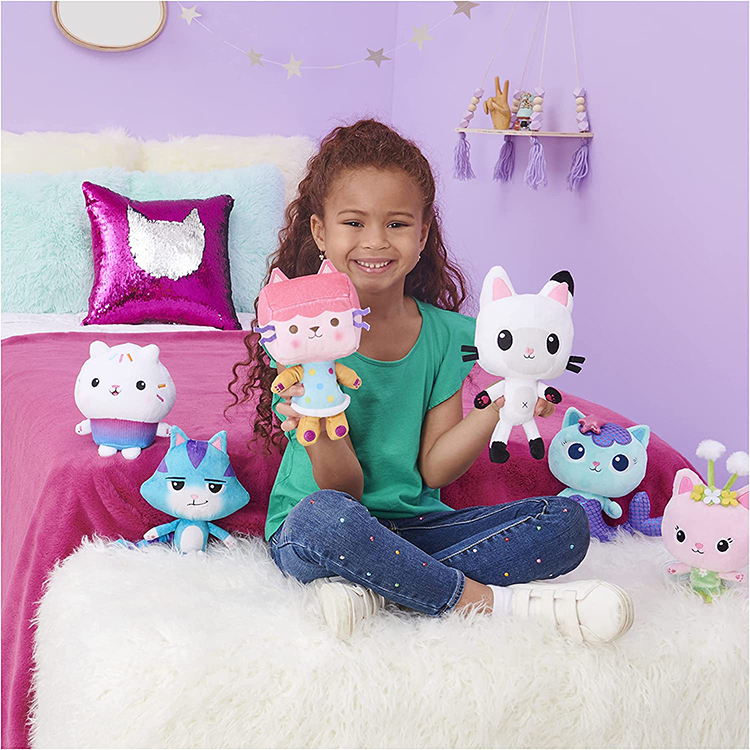The Classification of Plush Toys’ Materials
Plush toys are made of plush fabrics and other textile materials, filled with flocculent fillers such as PP cotton, material fillers, particle fillers, etc. People also call plush toys on the market soft toys, stuffed toys, etc.
Fabrics
Plush toys are mainly made of the plush fabrics, but leather, toweling, velvet, cloth, nylon taffta, polar fleece, Lycra and a variety of other fabrics have also been introduced into the production of toys.
According to the thickness, fabrics can be divided into three categories: thick fabrics (plush fabrics), medium thick fabrics (thin velvet fabrics) and thin fabrics (cloth and silk fabrics). Among these three kinds of fabrics, the most commonly seen fabrics are the medium thick fabrics such as the short floss, polar fleece, coral fleece, bright velvet, velvet, toweling, etc.
Filling materials
1) Flocculent fillers: The most commonly used flocculent filler is the PP cotton, and the plush toys will be filled with the PP cotton by machines or by hand when the PP cotton becomes fluffy after processing.
2) Material fillers: The most commonly seen material filler is the stereotypes cotton. The stereotypes cotton has various thickness specifications and it can be cut. Polyfoam is made from polyurethane through the foaming process and it looks like sponge, loose and porous.
3) Particle fillers: Particle fillers include the plastic particles such as polyethylene, polypropylene, foaming particles and plant particles which are made from the plant leaves or petals.
Ingredients
1) Eyes, also called the plastic eyes, crystal eyes, cartoon eyes, etc.
2) Noses, also called the plastic noses, flocking noses, etc.
3) Satin ribbons
Production processes
The production processes of plush toys include shape design, proofing, layout, tailoring, sewing, binding eyes and noses, filling seal, binding shape, finishing modification, molding, stitch examination, packing and storage.
1) Give the sample plate which is submitted by the design department or the customer to the cutting and molding workshops.
2) Sewing the plush toys through the sewing machine, mainly sewing the bodies, the labels and the accessories.
3) Fix the noses, eyes and other accessories.
4) Fill the plush toys with the cotton through the filling machines.
5) Stitch and then shape the cotton filling mouth to make it trim.
6) Inspect the plush toys, cutting the excessive thread ends and removing the fluff.
7) Blow the fluff on the plush toys with the high pressure pump.
8) Make hang tags.
9) Pack and deliver the plush toys.
Fabrics
Plush toys are mainly made of the plush fabrics, but leather, toweling, velvet, cloth, nylon taffta, polar fleece, Lycra and a variety of other fabrics have also been introduced into the production of toys.
According to the thickness, fabrics can be divided into three categories: thick fabrics (plush fabrics), medium thick fabrics (thin velvet fabrics) and thin fabrics (cloth and silk fabrics). Among these three kinds of fabrics, the most commonly seen fabrics are the medium thick fabrics such as the short floss, polar fleece, coral fleece, bright velvet, velvet, toweling, etc.
Filling materials
1) Flocculent fillers: The most commonly used flocculent filler is the PP cotton, and the plush toys will be filled with the PP cotton by machines or by hand when the PP cotton becomes fluffy after processing.
2) Material fillers: The most commonly seen material filler is the stereotypes cotton. The stereotypes cotton has various thickness specifications and it can be cut. Polyfoam is made from polyurethane through the foaming process and it looks like sponge, loose and porous.
3) Particle fillers: Particle fillers include the plastic particles such as polyethylene, polypropylene, foaming particles and plant particles which are made from the plant leaves or petals.
Ingredients
1) Eyes, also called the plastic eyes, crystal eyes, cartoon eyes, etc.
2) Noses, also called the plastic noses, flocking noses, etc.
3) Satin ribbons
Production processes
The production processes of plush toys include shape design, proofing, layout, tailoring, sewing, binding eyes and noses, filling seal, binding shape, finishing modification, molding, stitch examination, packing and storage.
1) Give the sample plate which is submitted by the design department or the customer to the cutting and molding workshops.
2) Sewing the plush toys through the sewing machine, mainly sewing the bodies, the labels and the accessories.
3) Fix the noses, eyes and other accessories.
4) Fill the plush toys with the cotton through the filling machines.
5) Stitch and then shape the cotton filling mouth to make it trim.
6) Inspect the plush toys, cutting the excessive thread ends and removing the fluff.
7) Blow the fluff on the plush toys with the high pressure pump.
8) Make hang tags.
9) Pack and deliver the plush toys.



